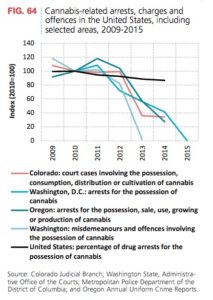
Within the U.S. the legalization of medical and recreational marijuana has rapidly increased over the past few years, but not without some disturbing trends. One of these is the rise in THC potency within cannabis. The 2016 World Drug Report (2016 WDR) indicated that cannabis THC potency in the U.S. has been increasing over the past thirty years. It went from less than 3.4% in 1993 to 8.8% in 2008. Bloomberg reported that more recent data suggests that THC potency in cannabis increased to 12.6% in marijuana seized by authorities in 2013. In states where recreational marijuana is legal, such as Colorado and Washington, some samples have reached as high as 30%, with the average around 17%, according to the 2016 WDR.
Mehmedic et al. published an article in the September 2010 edition of the Journal of Forensic Sciences that also concluded the increasing potency of THC in cannabis. While there was the above noted increase of THC in cannabis seized by authorities, the CBD concentration increased only slightly, from .3% to .4%. The cannabinoid with the greatest known medical potential in marijuana is CBD, not THC. The researchers concluded not only was cannabis more potent, the market share for higher-potency products was increasing. “The question now becomes: What are the effects of the availability of high-potency products on cannabis users?”
A partial explanation for the increased potency in legal commercial markets like Colorado is the popularity of edible cannabis products made with cannabis extract-based concentrates such as oil, “wax,” or “shatter.” The THC potency of these extracts can be up to 80-90 percent. In 2014, edible products accounted for an estimated 35% of retail sales of recreational marijuana in Colorado. This makes it difficult to determine the dose or amount of THC ingested in an edible, leading to potential over-intoxication. “With edible products, the slower onset and longer duration of intoxication could increase the risk of over-intoxication, especially for new or inexperienced users.”
One way of regulating this concern has been to implement stringent labeling and packaging requirements. Washington and Colorado require edibles to have a 10mg serving size of THC. Alaska and Oregon have drafted legislation to set the serving size at a maximum of 5 mg of THC. The increasing potency has not been the only concern within states where marijuana is now legal.
Since the legalization of recreational marijuana in Colorado and Washington, incidents of accidental ingestion of cannabis among young children have been increasing. The Washington Poison Control center reported the number of cannabis exposure calls for people under 20 doubled from 2010 to 2014. In Colorado, within one year of legalization there was a 29% increase in the number of marijuana-related ER visits and a 38% increase in the number of cannabis-related hospitalizations.
More people using marijuana recreationally means an increase in the number of individuals driving under the influence of marijuana. The 2016 WDR said studies suggested that although cannabis seemed to be less hazardous than alcohol with regard to driving impairment, it is much more dangerous when used in combination with alcohol. In both Colorado and Washington there have been increases in the percentages of crashes and fatal crashes of drivers who tested positive for marijuana from 2012 to 2015.
Not surprisingly, the number of arrests and court cases with cannabis-related offences dropped substantially in state that have legalized marijuana. But data on other marijuana-related offences such as citations or warnings for public consumption were not readily available. See the following chart taken from the 2016 WDR.
 However, there has been a ripple effect of drug concerns in the states adjacent to states where recreational marijuana is legal. In December of 2014, Nebraska and Oklahoma sued Colorado, requesting that the U.S. Supreme Court reverse Colorado’s decision to legalize marijuana, as it had led to an increase in trafficking marijuana in these neighboring jurisdictions. Attorneys for Colorado and the Obama administration asked the Supreme Court not take up the lawsuit. But as it turned out, the Court was also reluctant to take on the dispute as well.
However, there has been a ripple effect of drug concerns in the states adjacent to states where recreational marijuana is legal. In December of 2014, Nebraska and Oklahoma sued Colorado, requesting that the U.S. Supreme Court reverse Colorado’s decision to legalize marijuana, as it had led to an increase in trafficking marijuana in these neighboring jurisdictions. Attorneys for Colorado and the Obama administration asked the Supreme Court not take up the lawsuit. But as it turned out, the Court was also reluctant to take on the dispute as well.
The Supreme Court justices spent more than a year pondering whether to take the case. The proposed lawsuit was scheduled and re-scheduled five times for a closed-door conference, where the justices would debate the merits of taking the case.
In March of 2016 the Supreme Court declined by a vote of 6-2 to hear their complaint against Colorado. But the vote did not rule out future challenges. The Colorado Attorney General said that while the state has had several legal victories in federal lawsuits surrounding Amendment 64 legalizing recreational marijuana, Nebraska and Oklahoma’s concerns will not disappear. Doug Peterson, the Nebraska Attorney General was quoted by the Denver Post as saying: “The Court’s decision does not bar additional challenges to Colorado’s scheme in federal district court.” The Oklahoma Attorney General, Scott Pruitt said:
The fact remains — Colorado marijuana continues to flow into Oklahoma, in direct violation of federal and state law. Colorado should do the right thing and stop refusing to take reasonable steps to prevent the flow of marijuana outside of its border. And the Obama administration should do its job under the Constitution and enforce the Controlled Substances Act. Until they do, Oklahoma will continue to utilize every law enforcement tool available to it to ensure that the flow of illegal drugs into our state is stopped.
The federal government cannot continue to sit on the sidelines while recreational marijuana laws take hold state-by-state. The medical potential needs to be scientifically delineated and a step towards that is rescheduling marijuana as a Schedule II controlled Substance. The adverse effects of increased THC potency should be investigated, monitored and ultimately regulated. The collateral harm in neighboring states where marijuana is not legal should be dealt with cooperatively between states or result in federally mediated changes. Continuing a head-in-the-sand approach at the federal level is no longer a viable option.
The United Nations Office on Drugs and Crime (UNODC) publishes a yearly report giving a global overview of the supply and demand of various drugs and their impact on health. This is one of a series of articles discussing information from the 2016 World Drug Report.





